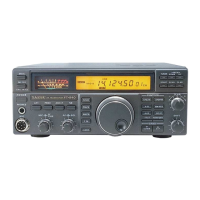
Do you have a question about the Yaesu FT+850 and is the answer not in the manual?
| Brand | Yaesu |
|---|---|
| Model | FT+850 |
| Category | Transceiver |
| Language | English |
Details of buttons, knobs, and switches on the front panel.
Description of jacks like PHONES and MIC on the front panel.
Explanation of indicators and frequency display elements.
Description of various input/output jacks on the rear panel.
Usage of S-meter for reception and PO scale for transmission.
How the ALC scale indicates transmitter performance.
High-performance transceiver capabilities and design.
Overview of optional accessories like tuners and speakers.
Power output, modulation, radiation, and audio response.
Sensitivity, selectivity, squelch, and IF rejection.
FC-10 and FC-800 automatic antenna tuners.
IF Crystal Filters, FM Unit, CAT Interface.
MH-1B8 and MD-1C8 microphone details.
Initial checks upon opening packaging.
Powering the transceiver, recommendations for Yaesu FP-800.
Procedure to change the FP-800 power supply voltage range.
Proper placement for ventilation and importance of earth ground.
Requirements for antennas and feedlines, SWR issues.
Connecting DC cable to vehicle battery for mobile use.
Using the MMB-20 mounting bracket for vehicle installation.
Managing the lithium battery and backup switch for memory retention.
Setting up antennas for mobile operation.
Diagrams for connecting external accessories.
Pinouts for TUNER 1, TUNER 2, and CAT jacks.
Pinouts for PHONES, KEY, RCA PLUG, and EXT SPKR.
Diagrams for FL-7000 and other linear amplifiers.
Customizing features by holding buttons during power-up.
Using FAST button with other keys for specific functions.
Basic steps for initial operation and display check.
Adjusting frequency, band selection, and display features.
Using NB, IF Shift, and filters to mitigate interference.
Utilizing external tuners for SWR matching.
Transmitting in LSB/USB modes, MIC and PWR adjustments.
Transmitting in CW, pitch, sidetone, and reverse sideband.
AM power limits and FM repeater operation.
Using VFOs, split operation, and memory features.
Channel, group, and programmed memory scanning.
Connecting TNCs and computers for digital communication.
Setting up for AFSK tones and computer RFI.
Steps to access internal components by removing the top cover.
Installing optional IF filters and FM unit.
Installing the enhanced stability oscillator.
Replacing the battery and managing the memory backup switch.
Format and sending of CAT commands.
Understanding status updates and data formats.
BASIC examples for sending commands and reading data.